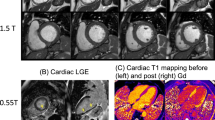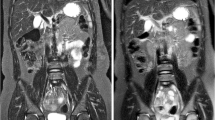Abstract.
The idea of a non-ionizing high-resolution technique to screen the entire body for occult disease is immensely appealing. This article outlines an evolving technique, controversies and clinical application of whole-body scanning using MRI with turbo short tau inversion recovery tissue excitation.









Similar content being viewed by others
References
Eustace S, Tello R, DeCarvalho V et al. (1997) A comparison of whole-body turbo short tau inversion recovery MR imaging and planar technetium 99m methylene diphosphonate scintigraphy in the evaluation of patients with suspected skeletal metastases. AJR 169:1655–1661
O'Connell MJ, Powell T, Brennan D, Lynch T, McCarthy C, Eustace SJ (2002) Whole-body MR imaging in diagnosis of polymyositis. AJR 179:967–971
Phelps ME (2000) PET: the merging of biology and imaging into molecular imaging. J Nucl Med 41:661–681
Johnson KM, Leanitt JD, Kayser HW (1997) Total-body MR imaging in as little as 18 seconds. Radiology 202:262–267
Barkhausen J, Quick HH, Lauenstein T, Goyen M (2001) Whole-body MR imaging in 30 seconds with real time FISP and a continuously rolling table platform: feasibility study. Radiology 220:252–256
Lauenstein TC, Goehde SC, Herborn CU, Treder W, Ruehm SG, Debatin JF, Barkhausen J (2002) Three dimensional volumetric interpolated breath hold MR imaging for whole-body tumor staging in less than 15 minutes: a feasability study. AJR 179:445–449
EL Khoury GY et al. (2000) Metastatic bone disease. ACR appropriateness criteria. Am Coll Radiol 215:283–285
O'Connell MJ, Hargaden G, Powell T, Eustace SJ (2002) Whole-body short tau inversion recovery MR imaging using a moving tabletop. AJR 179:866–868
Steinborn MM, Heuck AF, Tiling R, Bruegel M, Gauger L, Reiser MF (1999) Whole-body bone marrow MRI in patients with metastatic disease to the skeletal system. J Comput Assist Tomogr 23:123–129
Lauenstein TC, Freundenberg LS, Goehde SC, Ruehm SG, Goyen M, Bosk S, Debatin JF, Barkhausen J (2002) Whole-body MRI using a rolling table platform for the detection of bone metastases. Eur Radiol 12:2091–2099
Walker R, Harper K, Eustace S (2000) Whole-body turbo STIR MR imaging in breast carcinoma: preliminary clinical experience. J Magn Reson Imaging 11:343–350
Eustace S. Tello R, Yucel EK (1998) Whole-body turbo STIR MR imaging in unknown primary tumor detection. J Magn Reson Imaging 8:751–753
Mazumdar A, Siegel MJ, Narra V, Luchtman-Jones L (2002) Whole-body fast inversion recovery MR imaging of small cell neoplasms in pediatric patients: a pilot study. AJR 179:1261–1266
Abbruzzese JL, Abbruzzese MC, Lenzi R et al. (1995) Analysis of a diagnostic strategy for patients with suspected tumors of unknown origin. J Clin Oncol 13:2094–2103
Vande Berg BC, Lecouvet FE, Michaux L et al. (1996) Stage 1 multiple myeloma: value of MR imaging of the bone marrow in the determination of prognosis. Radiology 201:243–246
Eustace S, Walker RE, Blake M, Yucel EK (1999) Whole-body MR imaging, practical issues, clinical applications, and future directions. Magn Reson Clin N Am 9:209–235
Farber JM, Buckwalter KA (2002) MR imaging in nonneoplastic muscle disorders of the lower extremity. Radiol Clin North Am 40:1013–1031
Chan WP, Liu GC (2002) MR imaging of primary skeletal muscle diseases in children. AJR 179:989–997
Thomas EL, Saeed N, Hajnal JV et al. (1998) Magnetic resonance imaging of total body fat. Appl Physiol 85:1778–1785
Patriquin L, Kassarjian A, Barish M, Casserley L, O'Brien M, Andry C, Eustace S (2001) Postmortem whole-body magnetic resonance imaging as an adjunct to autopsy: preliminary clinical experience. J Magn Reson Imaging 13:277–287
Author information
Authors and Affiliations
Corresponding author
Additional information
Cappagh National Orthopaedic Hospital is a clinical sciences research site for Philips Medical Systems, Best, The Netherlands.
Rights and permissions
About this article
Cite this article
Kavanagh, E., Smith, C. & Eustace, S. Whole-body turbo STIR MR imaging: controversies and avenues for development. Eur Radiol 13, 2196–2205 (2003). https://doi.org/10.1007/s00330-003-1890-z
Received:
Revised:
Accepted:
Published:
Issue Date:
DOI: https://doi.org/10.1007/s00330-003-1890-z




